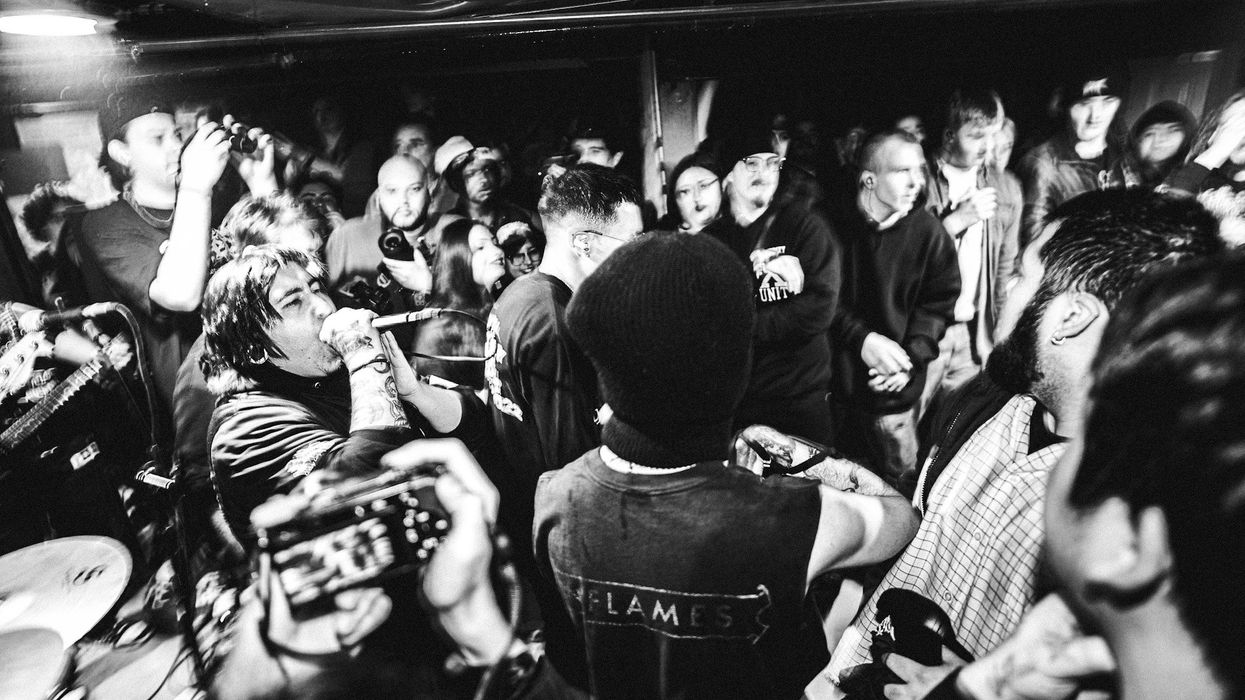In late February, Chicago cold- a little over a month into Trump’s second term as president- a hundred or so eager hardcore fans crowded in the cramped basement of a skateboard shop in Pilsen for a benefit show raising money for immigrants affected by Immigration and Customs Enforcement arrests.
Amid dust flying up from the cold concrete floor, sweaty bodies shoulder to shoulder, and a violent mosh pit, Yaretzi, an undocumented young Latina college student from the Southwest side of Chicago who frequents the city’s hardcore scene, was in the crowd, standing in solidarity with her community that is under attack.
“These bands and organizations are actively coming together and raising money for funds [and] donating to organizations that can actively help their community,” she said. “They are providing a space for people who may not feel safe in their own streets, in their own homes, to at least feel safe in one space for their community.”
At a time when tensions are high from the looming threat of increased ICE activity across the city, some young Chicagoans from immigrant backgrounds can find strength in the underground hardcore music community and the support that it cultivates.
Through benefit shows organized by DIY concert promoters on the Southwest side, funds have been raised for organizations helping families affected by ICE, and concertgoers who share in the struggle and anxiety of ICE activity in their neighborhoods have been able to view these events as a way of escaping their reality.
“People should come into the shows conscious of what they are there for,” said Crysta Hernandez, a Latina Southside resident and recent UIC graduate who frequents hardcore shows. “They know that they have some part in helping the community- the families- being affected.”
Since the beginning of his second term as president, Trump has made illegal immigration a focus of his administration, and has called on Homeland Security and ICE to make good on his promise of deporting “millions and millions” of immigrants across the country.
A day after the nationwide “No Kings” rallies, Trump issued an order to ICE to ramp up arrests in cities such as Los Angeles, New York, and Chicago. His call to increase arrests follows months of the agency conducting arrests on not only undocumented criminals, but also those not convicted of crimes.
With a little over 5 months into Trump’s second term, over 100,000 immigrants have been deported.
Most recently, his administration was able to pass the “One Big, Beautiful Bill,” which, among tax cuts and stripping Medicaid from millions of Americans, will give ICE $75 billion in federal funds to ramp up its deportation efforts.
Hardcore is a subgenre derived from punk rock, characterized by its fast tempo, aggressive instrumentation, and sometimes violent live shows, which include mosh pits and, a contentious topic in the genre, crowd-killing. Although the genre has gained popularity over the past few years, the world of hardcore has been an underground genre for decades, with concerts often hosted in unconventional venues such as VFW halls, basements, and art spaces.
Due to this, the genre has fostered a strong DIY (“Do-it-yourself”) ethic worldwide, with bands and community members taking concert organizing and promoting into their own hands, without the help of corporate entities.
Though Chicago’s DIY hardcore scene is not a new phenomenon and is not shy from political involvement, older Southwest side bands like Los Crudos acting as an example, today’s scene has taken a stance against the current administration’s goals of deporting massive amounts of undocumented immigrants.
Over the months of Trump’s second presidency, Ruidosa, a Latin American and POC artist collective from Chicago with ties to the city’s hardcore community, has focused on educating its community through grassroots gatherings across the city.
The collective has achieved this through organizing a variety of events, including poster making, protest organizing, artist panels, and a series of benefit shows held in February in Pilsen and June in Little Village.
Stephanie Herrera and Francisco Garcia, two co-founders of Ruidosa, recalled a sense of urgency to bring their community together following ICE arrests in Chicago at the end of January.
“Steph came to me and said, ‘We should have a benefit show, because people need to realize that this is a real thing that’s happening [and] give voices to people who can’t speak,’” Garcia said.
Within the first half hour of issuing the call to artists to perform, the February benefit show was complete, featuring bands such as Snuffed, Si Dios Quiere, Augment, Los Skin, and Punctured.
Mere minutes after opening the doors for the night of the event, the room was at capacity.
Juan Carlos Vargas, singer for the Southside hardcore band Augment, wishes that he could go back to that night and relive the energy and love that poured out through the audience.
Vargas, who comes from immigrant parents, views these shows as not only beneficial to those affected by ICE but also as important for bringing the hardcore community closer together through the music.
“I never really thought that a lot of people would be with us and behind us about everything that is going on,” he said. “Honestly, it was such an unreal experience.”
Through donations made at these shows, Ruidosa has raised approximately $ 4,000 and donated the funds to local and national organizations, including Mujeres Latinas en Acción, Border Kindness, and the Illinois Coalition for Immigrant and Refugee Rights, among others.
Though not at the benefit shows, Elizabeth Rosales, a Latina photographer from the Northwest side who comes from an immigrant background, views the hardcore scene as “very good” at fostering community, and admires artists and curators who are taking a stand against the current administration through benefit shows and donating funds to immigrant relief organizations.
“I think that community right now is more important than ever,” she said.
Hernandez, who attended the benefit show in June, believes that the hardcore scene not only views the gatherings as a way to escape, but also as a way to help others.
She is no stranger to getting in the mosh pit and views the activity as a way people get through hard times.
“I love the aggressiveness that comes with hardcore shows,” Hernandez said. “Some people cry it out, some people eat to cope, but some people just like to get wacked in the face.”
To Yaretzi, the undocumented college student who immigrated to the U.S. during the early years of her life, growing up in an immigrant family that couldn’t speak English fluently was “a journey.” From an early age, she had to take on a significant amount of responsibility to help her parents with everyday tasks that required English.
Discovering the city’s hardcore scene during her sophomore year of college, she found a community of like-minded people who shared similar experiences, and she feels that sense of unity is more apparent today than ever.
“There’s so much uncertainty on how I’m gonna navigate the world after college, but I think the support that I’ve gotten from my family and the community, it’s a little bit easier to deal with things at the end of the day,” Yaretzi said.
In terms of organizing more benefit shows and community gatherings, Ruidosa is showing no signs of stopping the momentum and views these events as creating space that they would’ve loved when they were younger.
Herrera, a first-generation citizen who comes from a single-parent immigrant family, gets emotional when she hears that people view the events as a way of escaping anxieties and fears of ICE.
“They say be the change you want to see in the world,” she said. “It’s very cliche, but it’s a testament to, like, ‘Wow, we really did this correctly,’ and the people that are supposed to be here are here and they’re responding.”
Matt Brady is a student journalist from the Chicagoland area, currently a reporter for the Columbia Chronicle, the student-led newspaper at Columbia College Chicago.



















